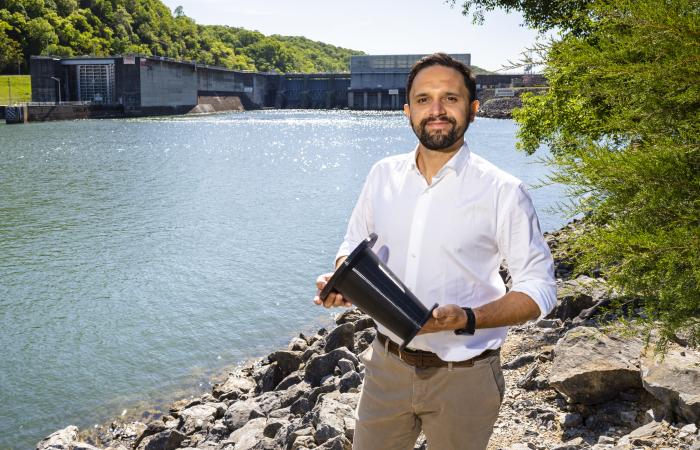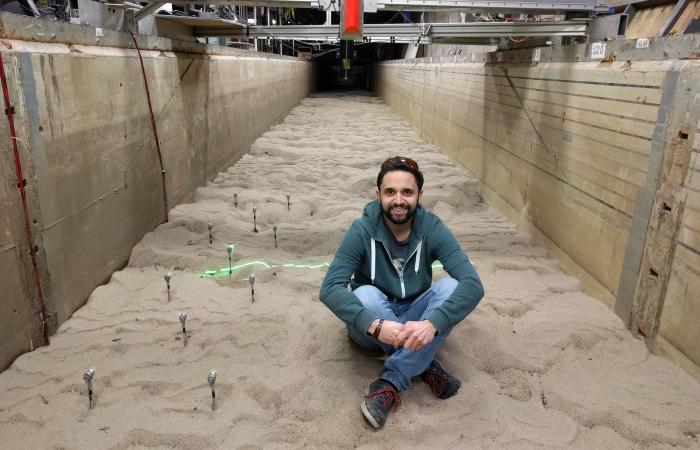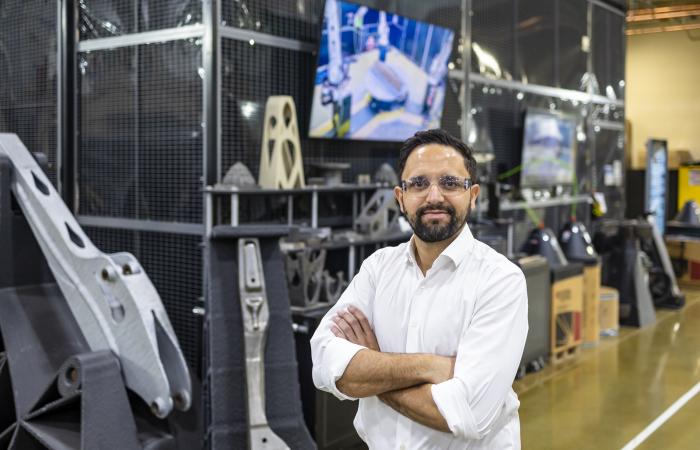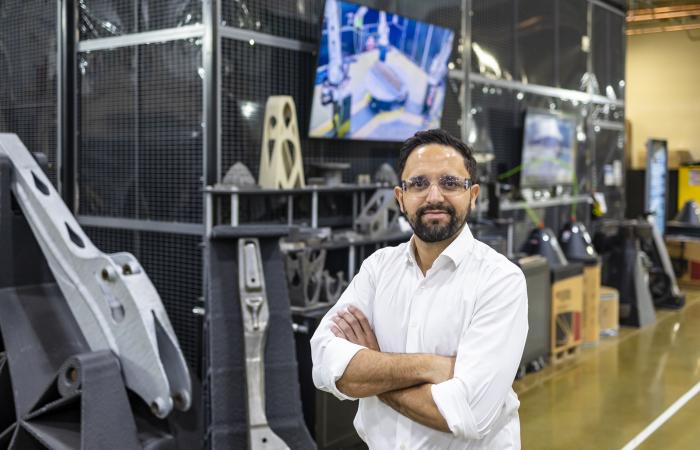Mirko Musa spent his childhood zigzagging his bike along the Po River. The Po, Italy’s longest river, cuts through a lush valley of grain and vegetable fields, which look like a green and gold ocean spreading out from the river’s banks.
But, as Musa grew up, he noticed something unnerving in this idyllic valley.
“I remember being shocked,” Musa said, remembering the day he stopped by a booth set up by environmental activists and saw blown-up satellite photos of northern Italy. “You could clearly see the gray smog cloud trapped in the Po Valley where I lived.”
Today, Musa’s life still revolves around water and pollution—only now, he’s not just observing from the sidelines — or shorelines. As an R&D associate staff member in the Water Resources Science and Engineering group at the Department of Energy’s Oak Ridge National Laboratory, he’s combining his childhood fascination with water with his urge to make that smog cloud disappear.
“Water power is a renewable form of energy that is ubiquitous; it’s everywhere and never stops,” said Musa. “Water is constantly running, rivers keep flowing and tides keep turning.”
Water power, which includes both hydropower and marine energy, is reliable and predictable. Musa is working to make these technologies more versatile, cost-effective and durable — so they can be as ubiquitous as water itself.
For example, Musa is studying how river currents could power river restoration, how ocean energy could generate clean hydrogen and whether advanced manufacturing—manufacturing that relies on smart technologies, faster and more sustainable processes, and automation — could help maintain and modernize the hydropower fleet. He recently published a report on advanced manufacturing for hydropower, with support from DOE’s Water Power Technologies Office.
Musa shared why he prefers to work in both hydropower and marine energy, how advanced manufacturing could benefit the hydropower industry and why his greatest dream is to capture energy from the mighty Mississippi River.
How did seeing the pollution hovering over the Po Valley in Italy influence your career path?
When I discovered how polluted northern Italy was, I wanted to study that. So, I enrolled in environmental engineering at the University of Trento in the Alps of Italy, which specializes in water resources engineering and river hydraulics — basically, the science of how water behaves and moves through the environment and how we can manage it sustainably.
I quickly realized that renewable energy was one of the answers — maybe the answer — to solve environmental issues and, more broadly, climate change, which is one of the biggest challenges for humanity right now, in my opinion. And if you combine hydraulics with renewable energy, you get water power technologies.
And that led you to pursue a doctoral degree at the University of Minnesota, right?
Yes. During my master’s program in Italy, I wanted to do an experience abroad. There was an opportunity to work in Minnesota with a professor who was starting a project on hydrokinetic turbines — basically wind turbines but in water. I was looking specifically at the effect of those machines on the morphology of the river — the Earth science part and how they may impact riverbed vegetation or the way sediment flows downriver. It was a perfect combination.
Before we get into your current work, what’s so great about water power? Why should people care about this renewable energy resource?
If we design technologies that are sustainable and respect the environment, water power will always play a crucial role in the overall transition to renewable energy. Not only can it integrate with the more variable resources like wind and solar, but hydropower specifically is very flexible and, right now, it's also the best way to store energy. So, water power is going to be a key component in our energy future. And to me, water is the coolest element.
Tell us about your current research. Are you still studying how hydrokinetic turbines interact with river environments?
At ORNL, which I joined as a postdoctoral scholar, I had to switch gears a little bit. Historically, my group, the Water Resources Science and Engineering Group, has worked more on the conventional side of water power — so, hydropower. But I built a good understanding of hydrokinetic energy during graduate school, and I wanted to expand on that. I like that I can now be in both worlds, spanning WPTO’s hydropower and marine energy programs.
Now, you’ve waded into the world of advanced manufacturing and materials, too, right? How does that fit into water power?
I became the lead on this project when one of my advisors left, which gave me a great opportunity to collaborate with a big division at ORNL that promotes energy-efficient, cost-effective ways to do sustainable and advanced manufacturing. Advanced manufacturing has been a revolution, helping the energy sector for decades and bringing manufacturing back to the United States. This project is a great opportunity to explore, for the first time, sustainable manufacturing for hydropower.
This is really the first time this has been explored? Even though hydropower is more than a century old?
Exactly. There was a disconnect between these two big realities, and I had the opportunity to bridge that gap. We organized an in-person workshop last August and brought in people from the hydropower industry, manufacturers, owners and operators, and experts in advanced manufacturing. We sat down and talked about current manufacturing challenges in hydropower and how advanced manufacturing could offer solutions.
What do those solutions look like?
The average age of U.S. hydropower plants is 64 years, so repairs and maintenance are starting to increase. At the same time, we have supply chain issues and a lack of large metal casting and forging capabilities in the United States. But large-scale metal hybrid manufacturing, which combines 3D printing and machining processes, could help decrease the time and cost to manufacture essential components, like turbine runners, and alleviate our reliance on foreign suppliers.
And robotics and advanced welding techniques could allow maintenance on-site, eliminating the need to disassemble and ship critical components to external repair shops, thus minimizing a hydropower plant’s downtime and revenue losses.
That’s huge. Any other examples?
New hydro will be small hydro, so dams that are less than 10 meters high. And we know that small projects cost more per kilowatt. But that’s the future that we need: to power small projects and retrofit non-powered dams, or dams that currently do not have the infrastructure to generate power. And here, too, 3D and hybrid manufacturing could reduce production time and capital costs, while enabling the adoption of non-conventional designs and shapes that may have been precluded so far by traditional manufacturing processes. Hopefully, this will also open the door to better environmental mitigations, like efficient, fish-friendly turbines and fish passages, and more flexible operations.
What excites you most about the future of water power?
I’m excited about the potential benefits of energy production in the ocean, like powering hydrogen production using marine energy, or, in rivers, using hydrokinetic turbines for river restoration projects, protecting the bank of a river from erosion. The turbines extract energy from the flow, which reduces the amount of force the river exerts on its banks and slows down how quickly the banks wear away. At the same time, the turbines can produce a little bit of energy that can be used for local energy production. That’s very niche, but it’s my thing.
In an ideal world, what would you hope to accomplish?
The dream that I’ve had since graduate school is to install hydrokinetic energy in the Mississippi River. The lab where I worked in graduate school literally diverts part of the river to flow through the building, so I always had a strong connection to it. And the lower Mississippi, near New Orleans, for example, is a perfect location for hydrokinetic energy. It’s deep and wide with strong currents.
What advice would you have for folks who might want to pursue a career in water power?
If you’re interested in renewable energy, please join us. Water power and renewable energy at large desperately need talented scientists and engineers. So, if that's the field you like, go for it.
UT-Battelle manages ORNL for DOE’s Office of Science, the single largest supporter of basic research in the physical sciences in the United States. The Office of Science is working to address some of the most pressing challenges of our time. For more information, please visit energy.gov/science.






